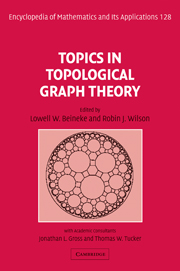Book contents
- Frontmatter
- Contents
- Foreword
- Preface
- Introduction
- 1 Embedding graphs on surfaces
- 2 Maximum genus
- 3 Distribution of embeddings
- 4 Algorithms and obstructions for embeddings
- 5 Graph minors: generalizing Kuratowski's theorem
- 6 Colouring graphs on surfaces
- 7 Crossing numbers
- 8 Representing graphs and maps
- 9 Enumerating coverings
- 10 Symmetric maps
- 11 The genus of a group
- 12 Embeddings and geometries
- 13 Embeddings and designs
- 14 Infinite graphs and planar maps
- 15 Open problems
- Notes on contributors
- Index
Preface
Published online by Cambridge University Press: 05 June 2012
- Frontmatter
- Contents
- Foreword
- Preface
- Introduction
- 1 Embedding graphs on surfaces
- 2 Maximum genus
- 3 Distribution of embeddings
- 4 Algorithms and obstructions for embeddings
- 5 Graph minors: generalizing Kuratowski's theorem
- 6 Colouring graphs on surfaces
- 7 Crossing numbers
- 8 Representing graphs and maps
- 9 Enumerating coverings
- 10 Symmetric maps
- 11 The genus of a group
- 12 Embeddings and geometries
- 13 Embeddings and designs
- 14 Infinite graphs and planar maps
- 15 Open problems
- Notes on contributors
- Index
Summary
The field of graph theory has undergone tremendous growth during the past century. As recently as fifty years ago, the graph theory community had few members and most were in Europe and North America; today there are hundreds of graph theorists and they span the globe. By the mid-1970s, the field had reached the point where we perceived the need for a collection of surveys of the areas of graph theory: the result was our three-volume series Selected Topics in Graph Theory, comprising articles written by distinguished experts in a common style. During the past quarter-century, the transformation of the subject has continued, with individual areas (such as topological graph theory) expanding to the point of having important sub-branches themselves. This inspired us to conceive of a new series of books, each a collection of articles within a particular area written by experts within that area. The first of these books was our companion volume on algebraic graph theory, published in 2004. This is the second of these books.
One innovative feature of these volumes is the engagement of academic consultants (here, Jonathan Gross and Thomas Tucker) to advise us on topics to be included and authors to be invited. We believe that this has been successful, the result being chapters covering the full range of areas within topological graph theory written by authors from around the world. Another important feature is that we have imposed uniform terminology and notation throughout, as far as possible, in the belief that this will aid readers in going from one chapter to another.
- Type
- Chapter
- Information
- Topics in Topological Graph Theory , pp. xvii - xviiiPublisher: Cambridge University PressPrint publication year: 2009
- 2
- Cited by



